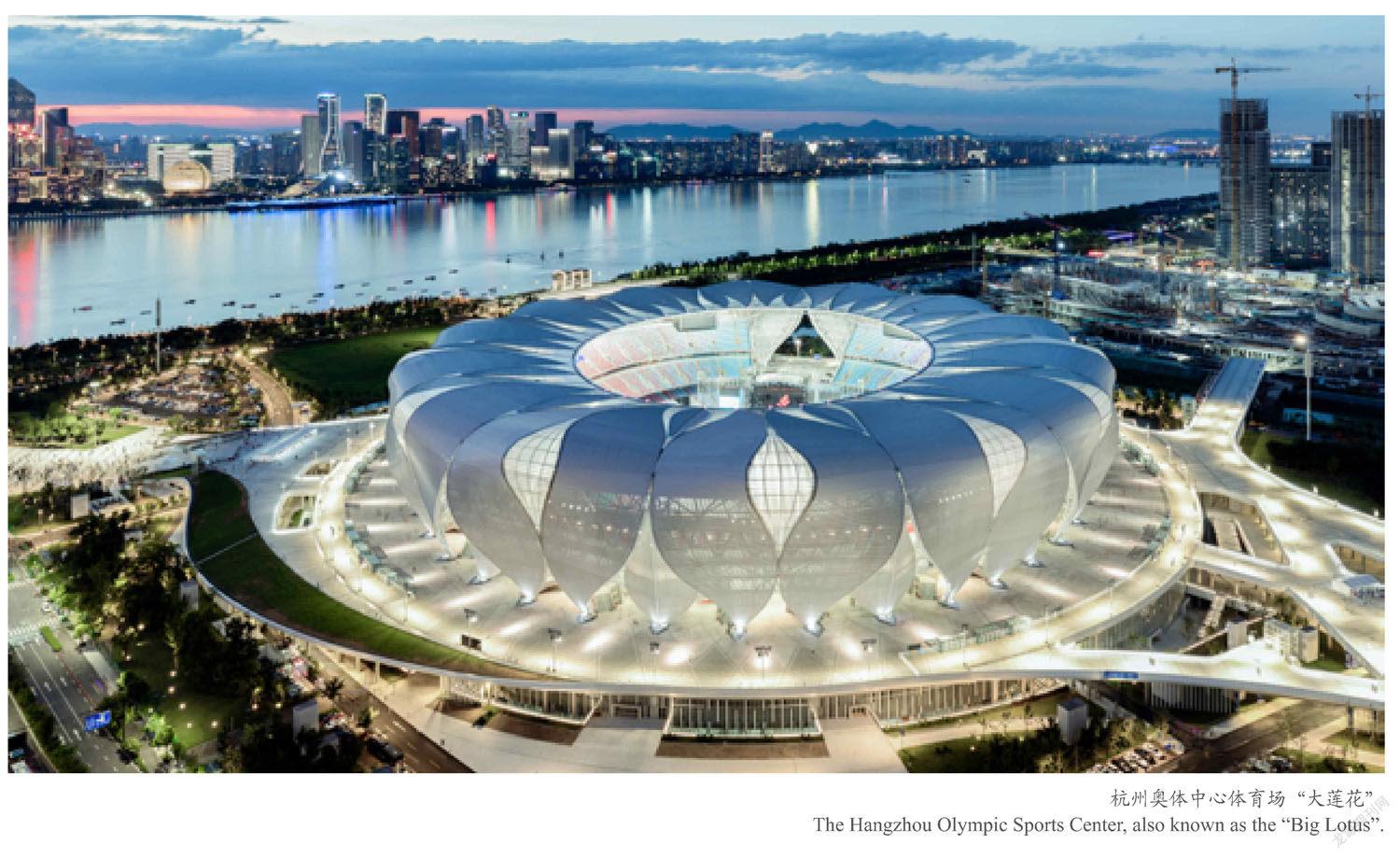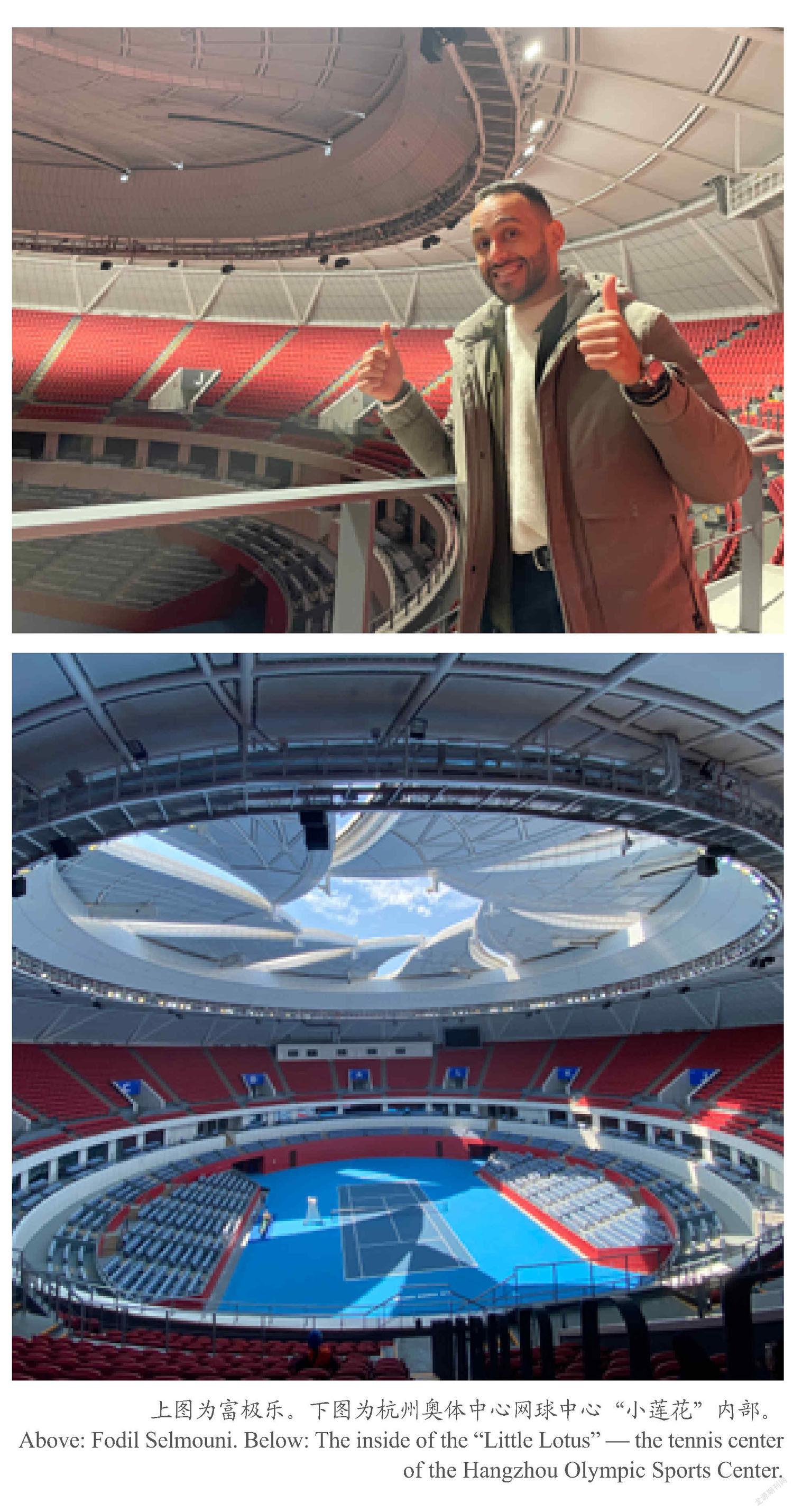钱塘江畔“并蒂莲”之奥妙
2022-03-28徐雅琪
徐雅琪



波涛汹涌的钱江潮,举世闻名。然而,坐落在杭州的钱塘江边的两朵亭亭玉立、含苞待放的并蒂莲,更是万人瞩目。这就是杭州奥体中心体育场和杭州奥体中心网球中心,因其美輪美奂的造型被盛赞为“大小莲花”。作为杭州亚运会的主场馆,它们又因其独具匠心的设计和极高的科技含量,成为名副其实的城市新地标。
届时,杭州奥体中心体育场“大莲花”将举行杭州亚运会的开闭幕式。大型体育赛事的开幕式向来是赛会的亮相之作,也是最华彩的部分。杭州亚运会的开幕式主创团队是一支由17名中外专家组成的国际融合“部队”。届时将由中国著名导演陆川担任总导演,著名导演沙晓岚任总制作人。主创团队将带领各自团队深耕灯光、舞美、音乐等专业领域,以高科技手段为依托,为观众带来一场全亚洲人的大联欢。
在2018年雅加达亚运会闭幕式上,备受瞩目的“杭州八分钟”文艺演出惊艳亮相,杭州正式接过亚运的旗帜。这也标志着这座充满科技感和历史文化底蕴的城市正式进入了亚运倒计时。2022年杭州亚运会,即第19届亚洲运动会,将于2022年9月10日至25日在中国浙江省杭州市举行。在保持40个大项不变的前提下,新增电子竞技、霹雳舞两个项目。
“大莲花”开启亚运联欢
亚运时钟一分一秒走动着,转眼已来到亚运筹办的关键阶段,只剩下一百多天了。
按照“中国新时代 · 杭州新亚运”的定位以及“中国风范、浙江特色、杭州韵味、共建共享”的目标,秉持着“绿色、智能、节俭、文明”的办会理念,坚持“以杭州为主,(浙江)全省共享”的办赛原则,杭州正在高质量稳步推进亚运会筹办工作。
随着杭州亚运会开幕时间日益临近,城市的亚运氛围越来越浓,大街小巷上 “亚运美学”的运用随处可见。亚运,成了世界了解杭州文化艺术和社会风貌再好不过的窗口。
“心心相融,@未来”是杭州亚运会的主题口号,口号的亮点@完美契合了杭州互联网之城的特征,科技赋能必定是杭州亚运会一个重要的关键词。
杭州亚运会、亚残运会共有57个比赛场馆。目前亚运场馆建设已经进入收官冲刺阶段,分布在浙江各地的亚运比赛场馆,逐渐揭开了它们神秘的面纱。
法籍友人探馆“并蒂莲”
那么,这两朵“并蒂莲”究竟妙在哪里呢?
本次寻访两朵莲花的主人公是Fodil Selmouni(中文名:富极乐)。他是法裔加拿大人,加拿大魁北克大学语言学硕士,来杭已六年多,现在是浙江旅游职业学院的一名老师,精通英、法、德、中四国语言,同时也是杭州城市报纸——都市快报英文有声栏目《Speak Hangzhou》(说杭州)的专栏作者,为杭州的国际化传播提供了许多支持和协助。
“每当走进杭州奥体中心体育场,我都会想起2008年的北京奥运会。当时我只有15岁,在加拿大通过电视观看了比赛和开闭幕式,对中国的喜爱从那时候就埋下了小小的种子。” 走访之前,富极乐就开始对自己的2008年北京奥运情怀津津乐道。
2018年12月,富极乐曾来到杭州奥体中心观看第14届世界短池游泳锦标赛,这片场地给他留下了深刻印象。
“我觉得‘大莲花’的建设过程非常复杂,因为它完完全全是原创的,无论是外部造型还是内部细节,都完美体现了艺术与科技的结合。”富极乐说。
作为专业田径比赛的场地,“大莲花”采用的是10直9弯“超宽”的塑胶跑道。与普通跑道不同,塑胶跑道的弹性和防滑性强,环保、耐磨损、易维护,可有效保护运动员的腿部关节,防止意外受伤,减少体力的消耗,提高竞赛成绩。
“大莲花”不仅在赛道上对标赛级高标准,更在馆内暗藏了智能化和人性化的高科技设备。
场馆内共设有8万多个采用渐变色彩设计的座椅,椅背上还有向前奔跑的运动员的图案,象征着运动健儿的拼搏精神。由于莲花造型特殊,为了让观众拥有最佳观赛体验,场馆内的看台斜度根据人体视线标准进行调整。节俭的办会理念贯穿在 “大莲花”方方面面的设计上,采用新光源、新技术和新设计,花瓣材料选用铝镁锰板。
尽管这并不是富极乐第一次来到“大莲花”,但他还是激动地表达了他对场馆造型的喜爱。“太棒了,外部硬朗的钢筋骨架转变为呼应场地曲线的柔美形态,动感飘逸的造型刚柔并济,让我每看一次都赞叹不已!”
“大莲花”整体由28片“大花瓣”和27片“小花瓣”组成。
一大一小自成单元,花瓣之间留有空白,恰似中国传统建筑中的景窗,将内部空间和外部景观联结起来。外立面穿孔金属板的运用,使得“大莲花”在不同的时间、不同的季节、不同的光线下都能表达不同的色彩和情绪。
富极乐所说的钢筋骨架正是场馆最具特色的地方。也正因为这个设计,该奥体主体育场钢结构工程在2014年获得了中国钢结构工程最高荣誉——“中国钢结构金奖”。
值得一提的是,“大莲花”是继国家体育场鸟巢和广东奥体中心体育场之后,全国第三大体育场馆。
作为在杭的外国友人,富极乐很关心亚运会的筹办进程。
在亚运年有机会进一步深入场馆走走看看,富极乐十分激动,频频拿出手机拍照留念。在“大莲花”的400米综合田径场跑道上,他更是忍不住迈开步子,来了一次沉浸式体验,带着小喘跑完了一整圈,瞬间感觉神清气爽。这可能就是体育运动的魅力吧。
探馆时恰逢中国的新春佳节,中国人的春节最讲究的就是团圆,但不少场馆建设者选择了留守,他们争分夺秒地工作着,力争为全世界人民奉献一个精彩绝伦的杭州亚运会。在“小莲花”,我们遇见了杭州奥体中心网球中心的工程主管张瑞华。春节期间,为了确保场馆安全,他选择留杭过年,与此同时,还有一大群亚运人和张瑞华一样,都选择了默默守护场馆建设。
“小莲花”将在亚运会赛时承担网球比赛项目,也是国内唯一获得国际网联二星认证的网球场地。此外,“小莲花”不仅场地达到了国际化标准,造型上也别具特色。建筑整体以“花瓣”作为设计元素,建筑结构采取桁架钢结构,让每片花瓣在视觉上相互独立,但实际上却为一个整体。下半部分由24片“小花瓣”组成,上半部分则是由8片会旋转的“大花瓣”构成。顶部的“大花瓣”采用了“旋转开闭屋盖”的技术,赛时通过开闭顶部的8片大花瓣,即可实现室内室外场景的转换。
张瑞华还向富极乐展示了他的“绝活”:用一只平板电脑,即可根据赛时功能变化调节不同的照明灯光。他说:“别看操作起来这么简单,这背后的系统工程是很多員工共同付出心血完成的,需要对每一个灯光设备都精准把控。”
杭州亚运会令人期待
“这些工作人员亲身投入到亚运的场馆建设中,很值得我们尊敬。我觉得他们也是亚运会的英雄。我很荣幸和他们交流,并了解他们感人的幕后故事。”富极乐真诚地说。
探馆结束后,富极乐表示,两朵“并蒂莲”让他常见常新,每一次都有不同的体验,深切地感受到杭州在亚运会场馆建设上的独特匠心和十足诚意,他已经对今年即将举办的杭州亚运会充满期待。“我非常希望能在比赛时买到一张门票到现场近距离观摩比赛,我也希望更多人来到美丽的杭州,共享这场精彩而隆重的体育盛宴!”富极乐说到。
Exploring the “Two Lotuses” before the Asian Games
By Xu Yaqi
At the closing ceremony of the 2018 Jakarta Asian Games, the high-profile “Hangzhou Eight Minutes” performance attracted huge attention and won international praise. Hangzhou, characterized by advanced science and technology and enriched by historical and cultural heritage, formally took over the flag, marking the beginning of the countdown for the next Asian Games.
The 19th Asian Games will be held in Hangzhou, Zhejiang province from September 10 to 25, 2022. Now comes the key stage of the preparation for the Games, with no more than 200 days left.
To host the “Great Asian Games in the New Era” with “Chinese Style, Zhejiang Glamour, Hangzhou Flavor”, which are “Green, Smart, Economical, Ethical”, the host city Hangzhou is steadily advancing its preparation for the event.
With the approaching of the Games, the atmosphere is building up. Decorations themed with the Games can be seen everywhere in the streets and alleys of the city, and the Asian Games have become more than a good window to understand Hangzhou.
“Heart to Heart, @Future”, the slogan of the Games, fits Hangzhou’s development as a vibrant internet city. Science and technology will definitely be two of the key words.
There are 57 venues for the Hangzhou Asian Games and Para Games, whose construction has already entered the final stage. The venues that are distributed all over Zhejiang are also gradually unveiled.
Known as the “Big and Little Lotuses”, the stadium and the tennis center of the Hangzhou Olympic Sports Center, located next to the Qiantang River, are highly praised for their beautiful shapes. As the main stadiums, they have become new landmarks of the city because of the unique design and the high technologies that are applied.
Indeed, the opening and closing ceremonies of the Hangzhou Asian Games will be held at the Big Lotus. The opening ceremony will be presented by an international team composed of 17 experts. Lu Chuan, one of the best-known Chinese directors, will act as the chief director and Sha Xiaolan the chief producer. The team will undoubtedly bring Asia a great gala.
So, why are the two “Lotuses” special?
Fodil Selmouni, a Canuck who graduated from the Université du Québec and is proficient in English, French, Germany, and Chinese, has been in Hangzhou for more than six years, and now is working as a teacher at Tourism College of Zhejiang. He is also the columnist of “Speak Hangzhou”, an audio column of the newspaper Dushi Kuaibao (or Urban Express). He has made many contributions to the city’s international communication.
“Whenever I stepped into the stadium of the Hangzhou Olympic Sports Center, I couldn’t help remembering the 2008 Beijing Olympic Games. At that time, I was only 15 years old, and I watched the Games, including the opening and closing ceremonies on TV in Canada, and since then my love for China is like small seeds that have gradually taken root.”
In 2018, Fodil came to the stadium and watched the 14th FINA World Short Pool Swimming Championships and was deeply impressed by the venue.
“I guess it is very complex to construct the Big Lotus, as it is completely original, not only in shape but also in its internal structure, perfectly reflecting the combination of art and technology,” said Fodil.
As a venue for track and field events, the Big Lotus is equipped with 10 straight and 9 curved “ultra-wide” plastic cement tracks. These tracks are characterized by strong elasticity and skid resistance, and are environmentally friendly and easy to maintain. They can effectively protect the knee joint knuckles of the athletes and avoid injuries.
The Big Lotus is built with not only high standards, but also endowed with intelligent and user-friendly high-tech facilities.
The pattern of athletes running forward is on the back of 80,000 seats with gradient color design, symbolizing the fighting spirit. In order to give the audience the best viewing experience, the slope of the stands in the stadium is adjusted according to the human sight. The concept of “being economical” is reflected in all areas of the Big Lotus, including the new light sources, new technologies, new designs, and new materials for the “flower petals”.
Although it was not the first time for Fodil to be in the Big Lotus, he still expressed his love for the design excitedly. “It is fantastic. The rigid external steel structure is transformed into a soft shape echoing the curve of the site, and the dynamic and elegant shape is both sturdy and soft. I can’t help admiring it every time I see it.”
The Big Lotus consists of 28 “large petals” and 27 “small petals”, which are complimentary to each other, leaving a space in-between and forming a special effect like the landscape window in traditional Chinese buildings. They connect the interior space and the external landscape. The use of perforated metal plates on the facade enables the Big Lotus to take on different colors and emotions according to different time, seasons and lights.
The steel bar structure is the most distinctive part of the venue. Thanks to this design, it won the stadium a prestigious prize — the China Steel Structure Gold Award in 2014.
One more thing worth mentioning is that the Big Lotus is the third largest stadium in China, after the National Stadium (the Bird’s Nest), and the Guangdong Olympic Sports Center Stadium.
As an international resident in Hangzhou, Fodil is closely follows the latest preparation progress of the Asian Games.
Thrilled to have the opportunity to visit the venues, he took out his mobile phone from time to time to take photos. On the 400-meter track of the Big Lotus, he could not help but run a whole circle, a bit out of breath but refreshed. This, perhaps, is the charm of sports.
At the Little Lotus, we met Zhang Ruihua, the project director of the tennis court. During the Spring Festival, he chose to stay in Hangzhou to take care of the security of the stadium, together with a large group of workers who are dedicated to the construction.
The Little Lotus is designated as the venue for tennis matches, and is the only one in China to win the ITF two-star certification.
The venue not only has reached international standards, but also has unique features. With the design of flower petals, the whole building adopts the structure of truss steel, as a result of which, each petal seems to be independent but in fact they are a whole. The lower half consists of 24 small petals, while the upper half is composed of 8 rotating large petals. The big petals at the top are designed to enable the switching between indoor and outdoor modes by opening and closing the roof.
Zhang also showed Fodil his “unique skills” by using a tablet computer to adjust different lights according to the functional changes. He said, “Although it seems easy to operate, the system is the joint efforts of many people, as it requires precise control of each lighting unit.”
“These workers fully dedicate themselves to the construction of the venues, and they are worthy of our respect. I think they are also the heroes of the Asian Games. I feel honored to talk with them and hear about their impressive stories,” Fodil said.
At the end of his visit, Fodil expressed his impression of the stadiums: the two Lotuses are new and different every time he sees them. Deeply touched by the ingenuity and sincerity of Hangzhou as seen in the Asian Games venues, he is full of expectation for the upcoming Hangzhou Asian Games. “I really hope that I can manage to buy tickets and watch the competitions in person. I also hope that more people will come to visit beautiful Hangzhou and enjoy this wonderful and grand sports feast!”
